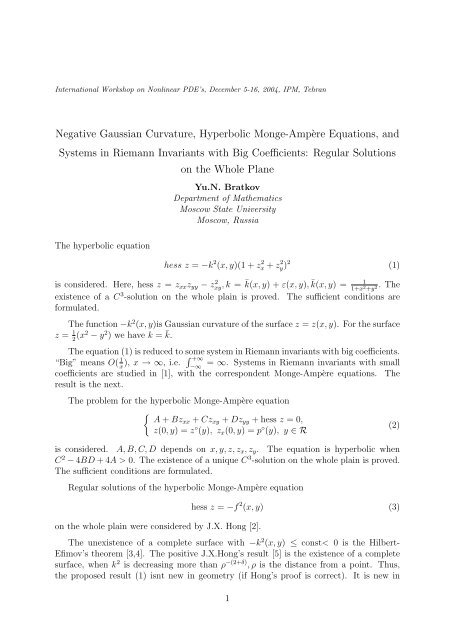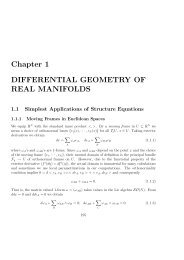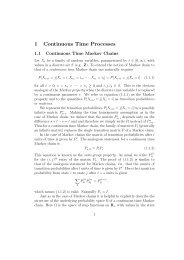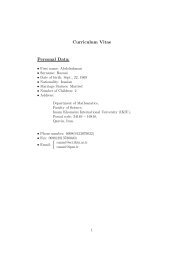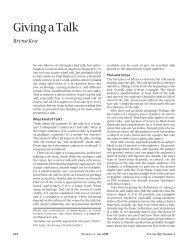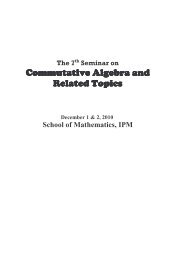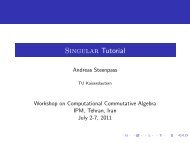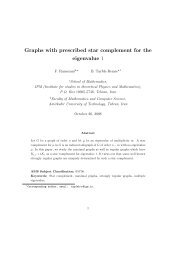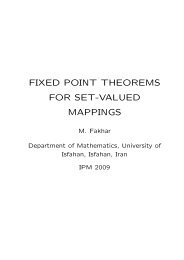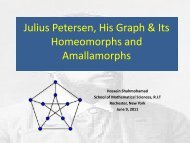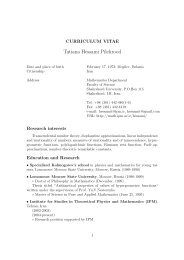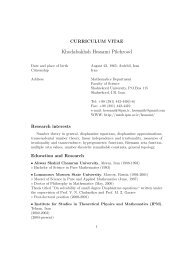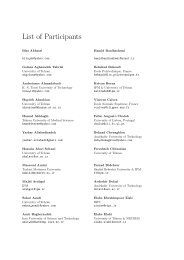Negative Gaussian Curvature, Hyperbolic Monge-Amp`ere ... - IPM
Negative Gaussian Curvature, Hyperbolic Monge-Amp`ere ... - IPM
Negative Gaussian Curvature, Hyperbolic Monge-Amp`ere ... - IPM
You also want an ePaper? Increase the reach of your titles
YUMPU automatically turns print PDFs into web optimized ePapers that Google loves.
International Workshop on Nonlinear PDE’s, December 5-16, 2004, <strong>IPM</strong>, Tehran<br />
<strong>Negative</strong> <strong>Gaussian</strong> <strong>Curvature</strong>, <strong>Hyperbolic</strong> <strong>Monge</strong>-Ampère Equations, and<br />
Systems in Riemann Invariants with Big Coefficients: Regular Solutions<br />
The hyperbolic equation<br />
on the Whole Plane<br />
Yu.N. Bratkov<br />
Department of Mathematics<br />
Moscow State University<br />
Moscow, Russia<br />
hess z = −k 2 (x, y)(1 + z 2 x + z 2 y) 2<br />
is considered. Here, hess z = zxxzyy − z 2 xy, k = ¯ k(x, y) + ε(x, y), ¯ k(x, y) =<br />
(1)<br />
1<br />
1+x2 +y2 . The<br />
existence of a C 3 -solution on the whole plain is proved. The sufficient conditions are<br />
formulated.<br />
The function −k 2 (x, y)is <strong>Gaussian</strong> curvature of the surface z = z(x, y). For the surface<br />
z = 1<br />
2 (x2 − y 2 ) we have k = ¯ k.<br />
The equation (1) is reduced to some system in Riemann invariants with big coefficients.<br />
“Big” means O( 1<br />
x ), x → ∞, i.e. +∞<br />
= ∞. Systems in Riemann invariants with small<br />
−∞<br />
coefficients are studied in [1], with the correspondent <strong>Monge</strong>-Ampère equations. The<br />
result is the next.<br />
The problem for the hyperbolic <strong>Monge</strong>-Ampère equation<br />
A + Bzxx + Czxy + Dzyy + hess z = 0,<br />
z(0, y) = z ◦ (y), zx(0, y) = p ◦ (y), y ∈ R<br />
is considered. A, B, C, D depends on x, y, z, zx, zy. The equation is hyperbolic when<br />
C 2 − 4BD + 4A > 0. The existence of a unique C 3 -solution on the whole plain is proved.<br />
The sufficient conditions are formulated.<br />
Regular solutions of the hyperbolic <strong>Monge</strong>-Ampère equation<br />
on the whole plain were considered by J.X. Hong [2].<br />
(2)<br />
hess z = −f 2 (x, y) (3)<br />
The unexistence of a complete surface with −k 2 (x, y) ≤ const< 0 is the Hilbert-<br />
Efimov’s theorem [3,4]. The positive J.X.Hong’s result [5] is the existence of a complete<br />
surface, when k 2 is decreasing more than ρ −(2+δ) , ρ is the distance from a point. Thus,<br />
the proposed result (1) isnt new in geometry (if Hong’s proof is correct). It is new in<br />
1
PDE. Also, our world isn’t R 3 or Minkowski space [6,7]. This old geometric problem<br />
(Lobachevski, Beltrami, Hilbert) seems to be non-actual now.<br />
To build regular solutions on the whole plain is an extremal kind of sport. If a domain<br />
isnt the whole plain, it is possible to move singularities outside the domain. Really it is<br />
the usual technic. It is impossible to move out when the domain is the whole plain. Thus,<br />
this is entirely another problem.<br />
References<br />
[1] Yu.N. Bratkov, On the existence of the classical solution of the hyperbolic <strong>Monge</strong>-<br />
Ampere equation on the whole, Fundamental and Applied Mathematics, 6(2000),<br />
379-390. (Russian)<br />
[2] Jiaxing Hong, The global smooth solutions of Cauchy problems for hyperbolic equation<br />
of <strong>Monge</strong>-Ampere type, Nonlinear Analysis, 24(1995), 1649-1663.<br />
[3] D. Hilbert, Über Flächen von constanter Gaußscher Krümmung. (1900) - In:<br />
Hilbert D. Grundlagen der Geometrie. - Leipzig ind Berlin: Verlag und Druck von<br />
B.G. Teubner, 1930, Anhang V.<br />
[4] N.V. Efimov, Impossibility of a complete regular surface in Euclidean 3-Space<br />
whose <strong>Gaussian</strong> curvature has a negative upper bound, Doklady Akad. Nauk SSSR,<br />
150(1963), 1206-1209. (Russian)<br />
[5] J.X. Hong, Realization in R 3 of complete Riemannian manifolds with negative<br />
curvature, Communications in Analysis and Geometry, 1(1993), 487-514.<br />
[6] Yu.N. Bratkov, Cult of mountains, exact geostructures, and cybernetic aspects of<br />
physics, Soznanie i Fizicheskaya Real’nost’, 8(2003), 40-51.(Russian)<br />
[7] Yu.N. Bratkov, Theory of hyperobjects, Moscow: MAX Press, 2001. (Russian)<br />
2


